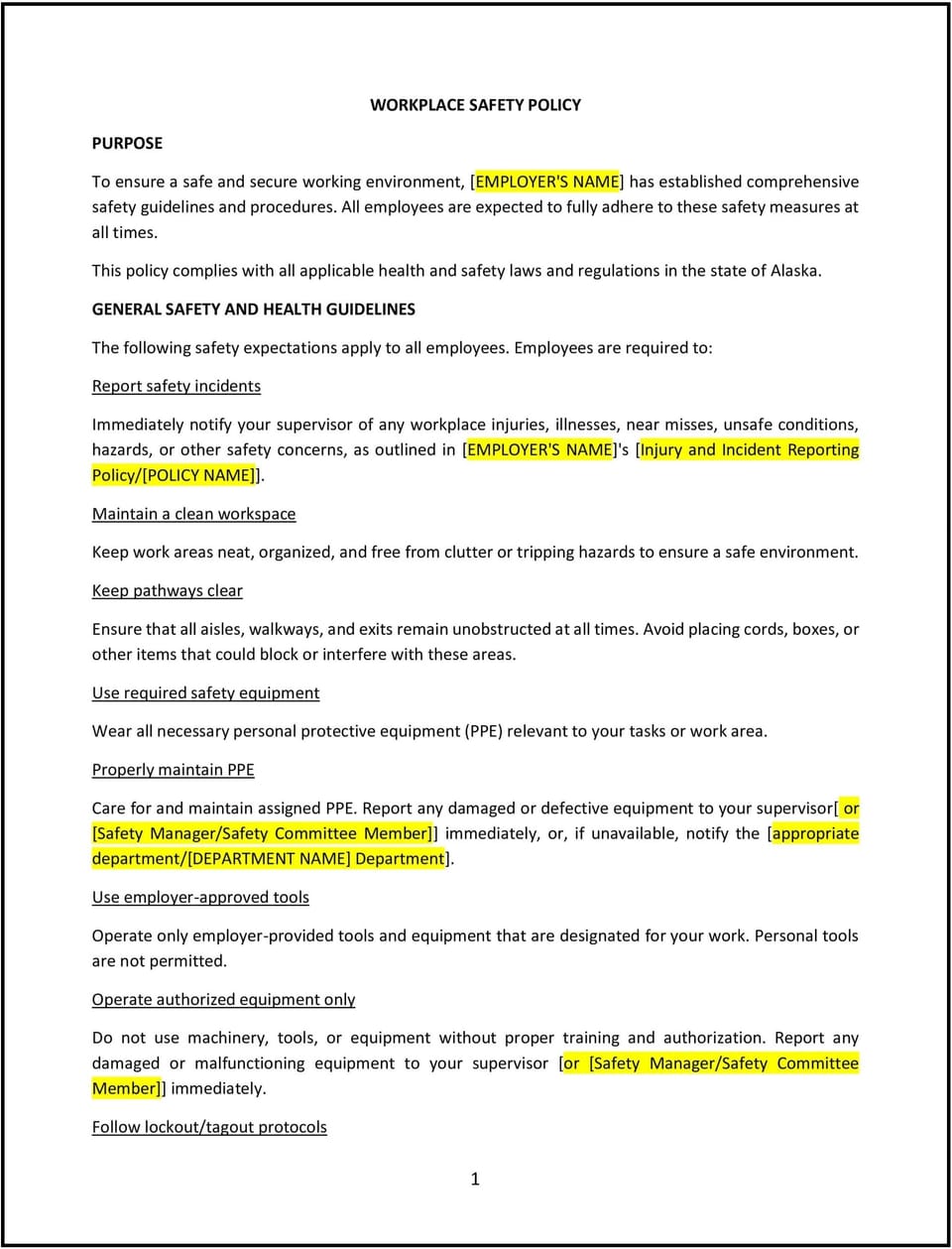Workplace safety policy (Alaska): Free template

Workplace safety policy (Alaska)
In Alaska, a workplace safety policy provides guidelines to ensure a secure and healthy work environment for all employees. This policy outlines safety protocols, employee responsibilities, and procedures for reporting hazards or incidents.
By implementing a workplace safety policy, businesses can minimize risks, comply with regulations, and foster a culture of safety.
How to use this workplace safety policy (Alaska)
- Define safety standards: Clearly specify the safety measures and practices required to protect employees from common risks, including those unique to Alaska’s industries and environment.
- Outline employee responsibilities: Provide guidance on how employees should follow safety protocols, report hazards, and use personal protective equipment (PPE).
- Include reporting procedures: Establish clear steps for employees to report safety concerns, near misses, or workplace injuries promptly.
- Provide emergency protocols: Detail actions to take in emergencies, such as natural disasters, fires, or medical incidents, with an emphasis on preparedness.
- Emphasize training: Require regular safety training for employees to ensure awareness and understanding of workplace safety practices.
Benefits of using a workplace safety policy (Alaska)
A workplace safety policy provides several advantages for businesses in Alaska. Here’s how it helps:
- Ensures compliance: Aligns with Alaska Occupational Safety and Health (AKOSH) standards and other applicable regulations.
- Promotes a safety culture: Encourages employees to prioritize safety and collaborate to maintain a hazard-free environment.
- Reduces risks: Minimizes the likelihood of workplace accidents, injuries, and illnesses.
- Protects employees: Provides clear guidelines for responding to emergencies, ensuring employee well-being.
- Enhances productivity: Reduces disruptions caused by incidents or injuries, allowing employees to focus on their work.
Tips for using a workplace safety policy (Alaska)
- Address Alaska-specific risks: Include measures for handling unique hazards, such as extreme weather, remote work environments, or wildlife encounters.
- Conduct regular inspections: Schedule routine safety audits to identify and address potential hazards in the workplace.
- Provide ongoing training: Offer periodic safety training tailored to your industry and workplace conditions.
- Involve employees: Encourage employees to participate in safety committees or initiatives to foster collective responsibility.
- Update regularly: Revise the policy as needed to reflect changes in regulations, workplace conditions, or industry standards.
Q: What responsibilities do employees have under this policy?
A: Employees must follow safety protocols, use PPE as required, report hazards or injuries promptly, and participate in safety training.
Q: How can businesses ensure compliance with Alaska’s workplace safety standards?
A: Regularly review AKOSH regulations, conduct safety audits, and provide ongoing training to ensure alignment with state requirements.
Q: What should businesses include in emergency response protocols?
A: Protocols should cover actions for natural disasters, medical emergencies, fires, or other incidents relevant to the workplace.
Q: How can businesses address workplace hazards proactively?
A: Conduct regular risk assessments, encourage employees to report hazards, and implement corrective measures promptly.
Q: How often should this policy be reviewed?
A: Review the policy annually or whenever significant changes occur in regulations, workplace conditions, or industry practices.
This article contains general legal information and does not contain legal advice. Cobrief is not a law firm or a substitute for an attorney or law firm. The law is complex and changes often. For legal advice, please ask a lawyer.


